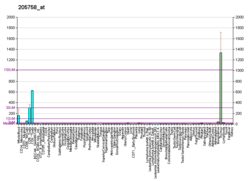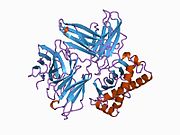CD8A
CD8a (Cluster of Differentiation 8a), is a human gene.[5]
Function
The CD8 antigen is a cell surface glycoprotein found on most cytotoxic T lymphocytes that mediates efficient cell-cell interactions within the immune system. The CD8 antigen, acting as a coreceptor, and the T-cell receptor on the T lymphocyte recognize antigen displayed by an antigen-presenting cell (APC) in the context of class I MHC molecules. The functional coreceptor is either a homodimer composed of two alpha chains, or a heterodimer composed of one alpha and one beta chain. Both alpha and beta chains share significant homology to immunoglobulin variable light chains. This gene encodes the CD8 alpha chain isoforms. Two alternative transcripts encoding distinct isoforms, one membrane associated and one secreted, have been identified.[5]
Interactions
CD8A has been shown to interact with:
See also
References
- ^ a b c GRCh38: Ensembl release 89: ENSG00000153563 - Ensembl, May 2017
- ^ a b c GRCm38: Ensembl release 89: ENSMUSG00000053977 - Ensembl, May 2017
- ^ "Human PubMed Reference:". National Center for Biotechnology Information, U.S. National Library of Medicine.
- ^ "Mouse PubMed Reference:". National Center for Biotechnology Information, U.S. National Library of Medicine.
- ^ a b "Entrez Gene: CD8A CD8a molecule".
- ^ Doucey MA, Goffin L, Naeher D, Michielin O, Baumgärtner P, Guillaume P, Palmer E, Luescher IF (January 2003). "CD3 delta establishes a functional link between the T cell receptor and CD8". J. Biol. Chem. 278 (5): 3257–64. doi:10.1074/jbc.M208119200. PMID 12215456.
- ^ a b Gao GF, Willcox BE, Wyer JR, Boulter JM, O'Callaghan CA, Maenaka K, Stuart DI, Jones EY, Van Der Merwe PA, Bell JI, Jakobsen BK (May 2000). "Classical and nonclassical class I major histocompatibility complex molecules exhibit subtle conformational differences that affect binding to CD8alphaalpha". J. Biol. Chem. 275 (20): 15232–8. doi:10.1074/jbc.275.20.15232. PMID 10809759.
- ^ Gao GF, Tormo J, Gerth UC, Wyer JR, McMichael AJ, Stuart DI, Bell JI, Jones EY, Jakobsen BK (June 1997). "Crystal structure of the complex between human CD8alpha(alpha) and HLA-A2". Nature. 387 (6633): 630–4. Bibcode:1997Natur.387..630G. doi:10.1038/42523. PMID 9177355. S2CID 4267617.
- ^ Sanders SK, Giblin PA, Kavathas P (September 1991). "Cell-cell adhesion mediated by CD8 and human histocompatibility leukocyte antigen G, a nonclassical major histocompatibility complex class 1 molecule on cytotrophoblasts". J. Exp. Med. 174 (3): 737–40. doi:10.1084/jem.174.3.737. PMC 2118947. PMID 1908512.
Further reading
- Parnes JR (1989). Molecular Biology and Function of CD4 and CD8. Advances in Immunology. Vol. 44. pp. 265–311. doi:10.1016/S0065-2776(08)60644-6. ISBN 9780120224449. PMID 2493728.
- Li L, Li HS, Pauza CD, Bukrinsky M, Zhao RY (2006). "Roles of HIV-1 auxiliary proteins in viral pathogenesis and host-pathogen interactions". Cell Res. 15 (11–12): 923–34. doi:10.1038/sj.cr.7290370. PMID 16354571.
- Stove V, Verhasselt B (2006). "Modelling thymic HIV-1 Nef effects". Curr. HIV Res. 4 (1): 57–64. doi:10.2174/157016206775197583. PMID 16454711.
- Nakayama K, Kawachi Y, Tokito S, Minami N, Yamamoto R, Imai T, Gachelin G, Nakauchi H (1992). "Recent duplication of the two human CD8 beta-chain genes". J. Immunol. 148 (6): 1919–27. doi:10.4049/jimmunol.148.6.1919. PMID 1541829. S2CID 8993127.
- Leahy DJ, Axel R, Hendrickson WA (1992). "Crystal structure of a soluble form of the human T cell coreceptor CD8 at 2.6 A resolution". Cell. 68 (6): 1145–62. doi:10.1016/0092-8674(92)90085-Q. PMID 1547508. S2CID 6261613.
- Erickson JD, Trojanowski JQ, Eiden LE (1991). "Regional distribution and partial molecular characterization of CD4-related mRNA in human brain and peripheral tissues". Brain Res. Mol. Brain Res. 10 (1): 23–31. doi:10.1016/0169-328X(91)90052-Y. PMID 1676132.
- Moebius U, Kober G, Griscelli AL, Hercend T, Meuer SC (1991). "Expression of different CD8 isoforms on distinct human lymphocyte subpopulations". Eur. J. Immunol. 21 (8): 1793–800. doi:10.1002/eji.1830210803. PMID 1831127. S2CID 46227655.
- Mittler RS, Rankin BM, Kiener PA (1991). "Physical associations between CD45 and CD4 or CD8 occur as late activation events in antigen receptor-stimulated human T cells". J. Immunol. 147 (10): 3434–40. doi:10.4049/jimmunol.147.10.3434. PMID 1834739. S2CID 21291442.
- Sanders SK, Giblin PA, Kavathas P (1991). "Cell-cell adhesion mediated by CD8 and human histocompatibility leukocyte antigen G, a nonclassical major histocompatibility complex class 1 molecule on cytotrophoblasts". J. Exp. Med. 174 (3): 737–40. doi:10.1084/jem.174.3.737. PMC 2118947. PMID 1908512.
- Barber EK, Dasgupta JD, Schlossman SF, Trevillyan JM, Rudd CE (1989). "The CD4 and CD8 antigens are coupled to a protein-tyrosine kinase (p56lck) that phosphorylates the CD3 complex". Proc. Natl. Acad. Sci. U.S.A. 86 (9): 3277–81. Bibcode:1989PNAS...86.3277B. doi:10.1073/pnas.86.9.3277. PMC 287114. PMID 2470098.
- Norment AM, Lonberg N, Lacy E, Littman DR (1989). "Alternatively spliced mRNA encodes a secreted form of human CD8 alpha. Characterization of the human CD8 alpha gene". J. Immunol. 142 (9): 3312–9. doi:10.4049/jimmunol.142.9.3312. PMID 2496167. S2CID 23835202.
- Nakayama K, Tokito S, Okumura K, Nakauchi H (1989). "Structure and expression of the gene encoding CD8 alpha chain (Leu-2/T8)". Immunogenetics. 30 (5): 393–7. doi:10.1007/BF02425282. PMID 2509342. S2CID 42149394.
- Giblin P, Ledbetter JA, Kavathas P (1989). "A secreted form of the human lymphocyte cell surface molecule CD8 arises from alternative splicing". Proc. Natl. Acad. Sci. U.S.A. 86 (3): 998–1002. Bibcode:1989PNAS...86..998G. doi:10.1073/pnas.86.3.998. PMC 286608. PMID 2536941.
- Aruffo A, Seed B (1989). "Expression of cDNA clones encoding the thymocyte antigens CD1a, b, c demonstrates a hierarchy of exclusion in fibroblasts". J. Immunol. 143 (5): 1723–30. doi:10.4049/jimmunol.143.5.1723. PMID 2701945. S2CID 23168239.
- Bowcock AM, Kavathas P, Margolskee RF, Herzenberg L, Cavalli-Sforza LL (1986). "An RFLP associated with pcDLeu2-14, a human T-cell differentiation antigen CD8 (Leu2) cDNA mapped to 2p12". Nucleic Acids Res. 14 (19): 7817. doi:10.1093/nar/14.19.7817. PMC 311807. PMID 2877435.
- Norment AM, Littman DR (1989). "A second subunit of CD8 is expressed in human T cells". EMBO J. 7 (11): 3433–9. doi:10.1002/j.1460-2075.1988.tb03217.x. PMC 454842. PMID 3145195.
- Littman DR, Thomas Y, Maddon PJ, Chess L, Axel R (1985). "The isolation and sequence of the gene encoding T8: a molecule defining functional classes of T lymphocytes". Cell. 40 (2): 237–46. doi:10.1016/0092-8674(85)90138-2. PMID 3871356. S2CID 35066139.
- Sukhatme VP, Sizer KC, Vollmer AC, Hunkapiller T, Parnes JR (1985). "The T cell differentiation antigen Leu-2/T8 is homologous to immunoglobulin and T cell receptor variable regions". Cell. 40 (3): 591–7. doi:10.1016/0092-8674(85)90207-7. PMID 3918796. S2CID 22206011.
- Parnes JR, Sizer KC, Sukhatme VP, Hunkapiller T (1986). "Structure of Leu-2/T8 as deduced from the sequence of a cDNA clone". Behring Inst. Mitt. (77): 48–55. PMID 3936473.
External links
- CD8a+protein,+human at the U.S. National Library of Medicine Medical Subject Headings (MeSH)
- Human CD8A genome location and CD8A gene details page in the UCSC Genome Browser.
- Human MAL genome location and MAL gene details page in the UCSC Genome Browser.
- Overview of all the structural information available in the PDB for UniProt: P01732 (Human T-cell surface glycoprotein CD8 alpha chain) at the PDBe-KB.
- Overview of all the structural information available in the PDB for UniProt: P01731 (Mouse T-cell surface glycoprotein CD8 alpha chain) at the PDBe-KB.
This article incorporates text from the United States National Library of Medicine, which is in the public domain.









